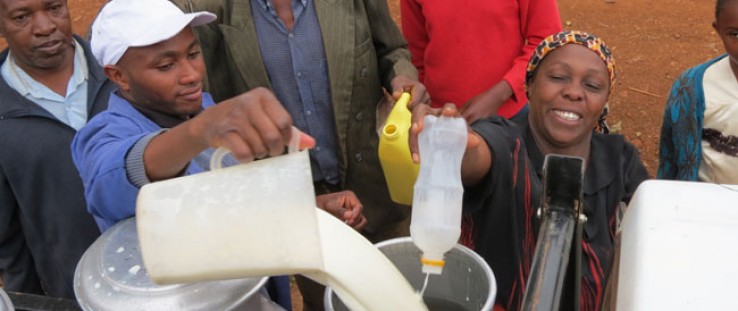 The morning ritual of testing and bulking the milk of hundreds of farmers.
Robin Johnson, USAID
The morning ritual of testing and bulking the milk of hundreds of farmers.
Robin Johnson, USAID
 The morning ritual of testing and bulking the milk of hundreds of farmers.
Robin Johnson, USAID
The morning ritual of testing and bulking the milk of hundreds of farmers.
Robin Johnson, USAID
Mary Rono used to fit the mold of the archetypal Kenyan dairy farmer. The 56-year-old retired government social worker living in the village of Kibomet in Kenya’s Rift Valley would milk her family’s herd of eight cows once a day. If an informal trader happened to pass by, she would sell the milk for a mere 18 shillings (or 22 cents) per liter. This, and the sale of vegetables from her garden, generated her only cash income.
In 2004, a sequence of events transformed her profession and her life. Rono visited a dairy cooperative in Nyala town that was receiving assistance from the now completed USAID/Kenya Dairy Development Program. She was introduced to simple, yet affordable techniques to increase her milk yield, such as milking her cows several times a day and growing her own fodder to feed the cows instead of letting them graze.
Thrilled by the improvements, Rono set out to find a better market for her fresh milk. She continued to receive advice from the subsequent USAID/Kenya Dairy Sector Competitiveness Program, and she helped form a cooperative so she could bulk her milk with other farmers. She was able to purchase two more heifers. In 2009, she started a self-help group with 15 members: Today, she is the chairperson of the 365-member Koitogos Dynamic Cooperative Society.
“We are now bulking more than 1,000 liters of milk per day, and receiving double the price per liter. We have been able to do a lot with the profits we get from the dairy. We are able to contribute to the school fees of our children. We are able to pay our loans with ease,” says Rono.
In Kenya, keeping cows has always been a way of life, but not a business. Now an emerging class of entrepreneurs like Rono is transforming the status quo with USAID support, fueling the drought-prone country’s dairy sector as an engine of economic growth and food security.
Land O’Milk
Since it began in mid-2008, the dairy program—implemented with agribusiness cooperative giant Land O’Lakes—has assisted more than 319,000 smallholder milk producers, as well as hundreds of processors, retailers and exporters up and down Kenya’s dairy value chain.
The result has been startling: an average income boost of $675 per rural farming family—more than $167 million overall. In a country where the average yearly income is $509, the extra cash goes far.
According to Mary Munene, a business development services specialist with the ongoing USAID/Kenya Dairy Sector Competitiveness Program, as Kenya’s dairy farmers become more entrepreneurial, they create a demand for new and better services. “Thousands of private-sector service providers have emerged as the Kenya dairy sector grows,” said Munene.
After running his petrol station on the main road in Kangema, in Muranga County, for 30 years, 52-year-old Joseph Githahu understands the limitations of the informal milk traders—Rono’s former milk merchants. Known locally as hawkers, many of them operate on motorbikes, stringing the plastic liter jugs of the milk they buy across the saddle and handlebars. The largest amount of milk some hawkers can collect, transport and sell in a day is around 20 liters. After that point, spoilage diminishes returns, and creates unhappy customers. With a profit margin of 10 shillings (12 cents) per liter, many hawkers found it difficult to pay expenses and feed their families, and, too often, Githahu reported, would fail to pay the farmers for the milk.
In 2009, Githahu decided to invest in professionalizing the milk-collection process that so many families in his rural community depend on for cash. He turned to the competitiveness program for information on the proper handling of fresh milk.
He took out a bank loan to buy his first truck. “In three years, I’ve worked up to having seven pick-up trucks, two 3-ton trucks and a 5-ton truck. My staff is trained on how to test the milk for bacteria and to ensure that no water has been added by farmers desperate for a few extra shillings,” says Githahu.
Githahu’s Kirere Dairy Services buys 8,000 liters of milk per day from smallholder farmers and sells it to large processors such as Brookside Dairy or New KCC. Every morning at 6 a.m., the Kirere fleet fans out to collect the milk along the routes that radiate from the dairy. Farmers wait at designated points with one, two or more liters of milk to sell. By 8:30 a.m., fresh milk arrives at the dairy to be transferred, can by can, to the cooler. Githahu began by investing in one, and then two, agitation coolers, at a cost of $20,000 each. But he has upgraded to a more high-tech—and, at $62,000, considerably more expensive—cooling system that cools the milk to the required 4 degrees Celsius rapidly.
Through the USAID dairy program, Githahu had access to advice on borrowing and supported the development of his business plan. Now, he is paying that knowledge forward. As he travels the different collection routes, he educates local farmers in the proper handling of the fresh milk and encourages them to buy nutritious feed to supplement the farm fodder they feed the cows.
“I keep investing my profits into the dairy,” Githahu explains. “This is a long-term investment in my community.”
Now, in addition to his milk collection, Githahu also offers the farmers feeds and artificial insemination services. “Purchasing and maintaining a high-quality bull is beyond the means of these farmers. But artificial insemination offers an affordable alternative,” he says.
Artificial insemination had previously been the sole domain of the Kenyan Government. “Today, 951 entrepreneurs are registered with the government as private providers of artificial insemination services,” says Julius Kiptarus, director of livestock production at Kenya’s Ministry of Livestock Development. “This is in line with our policy to foster a … modern agriculture sector that has the potential to pump an additional $1 billion into the economy.”
Getting Credit
Along with these new dairy value-chain entrepreneurs, private capital is also warming to the dairy sector. Kenya Commercial Bank (KCB) is the largest of several private banks and microfinance institutions to invest in its growth. Over the past two years, USAID’s Financial Inclusion for Rural Microenterprises project helped KCB develop an agriculture strategy and create a dairy lending business line, backed by $5 million in USAID loan guarantees and technical assistance to show them how lending to smallholders can be profitable.
In Kenya’s northern Rift Valley, KCB’s Eldoret West branch is offering dairy herd improvement loans, which Elseba Ndiema, a loan officer there, says is exactly what clients want. “We call it the ng’ombe loan, or dairy herd loan,” she says.
According to Ndiema, dairy farming only becomes profitable once a farmer is able to maintain a herd of six or more cows. The ng’ombe loan allows smallholder farmers to achieve that scale. Ndiema manages a portfolio of 30 dairy loans valued at $290,000. Approximately $9 million in dairy-related loans have been issued since January 2012 across the 32 KCB branches.
“For us at KCB—a large and conservative bank—lending into agriculture at the smallholder level and to others in the value chain that are not corporations was a major shift in thinking for us. Doing so would not have been possible without USAID’s research, product development and training,” says Wilfred Musau, director of retail banking.
KCB determines a dairy farmer’s creditworthiness based not on the traditional assessment of collateral, but rather by examining the purchase records of milk collection centers and processors. Milk purchasers are more than willing to share the information knowing that it will result in larger herds and more milk to buy.
Moving Toward Exports
According to the Kenya Dairy Board, the volume of milk going to the processing plants has increased nearly three-fold, from 144 million liters in 2002 to 549 million liters in 2011. Although there are 35 commercial processors, the three largest—New KCC, Brookside Dairy and Githunguri Dairy—control about 75 percent of the market.
“About 92 percent of Kenya’s dairy production is consumed locally and 8 percent is exported in the form of powdered milk and other long-lasting products,” says Machira Gichohi, managing director of the Kenya Dairy Board. “To continue to achieve the 7-percent growth rate envisioned in the government’s agricultural strategy, the dairy sub-sector is going to need to move towards exporting fresh dairy products and that’s going to require a greater investment in quality controls and cold storage facilities.”
Going Commercial
Since 1990, the number of smallholder farmers producing milk has increased by 260 percent. Today, dairy is responsible for 14 percent of Kenya’s agricultural GDP and 4 percent of the country’s total wealth, and supports 1.5 million smallholder farmers. Over 12 years, the sector has spawned more than 1.25 million private-sector jobs in milk transportation, processing, distribution and other industry support services.
“The dairy subsector has potential to improve the livelihoods of the majority smallholder family farmers and realize transformation from subsistence farming to a competitive, commercial and sustainable dairy industry for economic growth and wealth creation,” says Mohamed Abdi Kuti, minister for livestock development.
“I expect to see these transformational approaches to smallholder dairy farming continue to expand, even after the USAID-funded program is completed, to all 1.5 million rural Kenyan families that keep cows,” said Munene.
The dairy sector is a key part of the United States’ global hunger and food security initiative, also known as Feed the Future, in the East African country.
“The dairy sector is crucial in order to increase the incomes of rural farming families and contribute to the nutritional diversity of the nation’s diet. By producing more than they can eat and selling it on the market, rural farming families attain the resiliency to withstand crises such as drought, flooding or price spikes in staple foods,” says Mark Meassick, director of the agriculture office at USAID/Kenya.
Mary Rono says the cooperative model helped stave off hunger in Kibomet. During 2010 and 2011, some of the worst droughts in decades hit the Horn of Africa, resulting in famine in parts of Kibomet. However, Rono’s cooperative society was able to weather the dry period without losing income. “During that drought, most of the farmers did not have enough feed for their cows, so the cows could not produce enough milk to be sold and the farmers’ incomes dropped tremendously. A few families starved,” Rono remembers.
Said Rosaline Niega, a cooperative member: “Being in a cooperative, our milk had a higher price, and that helped us to earn money to feed our families.”







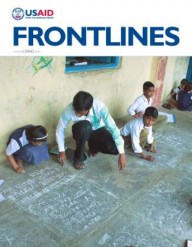

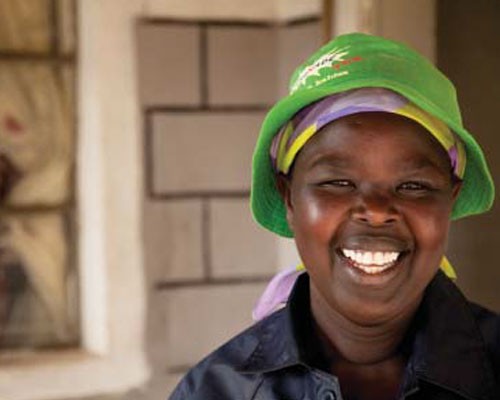

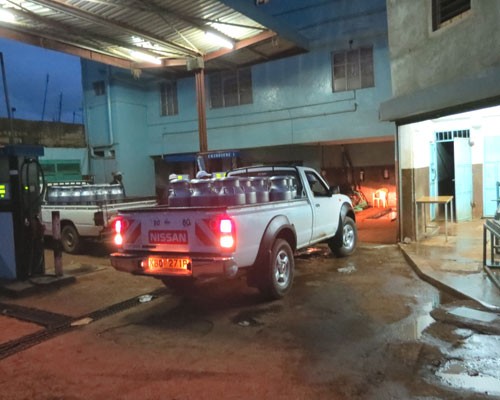
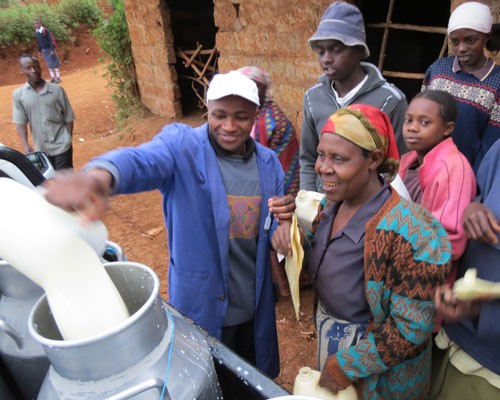
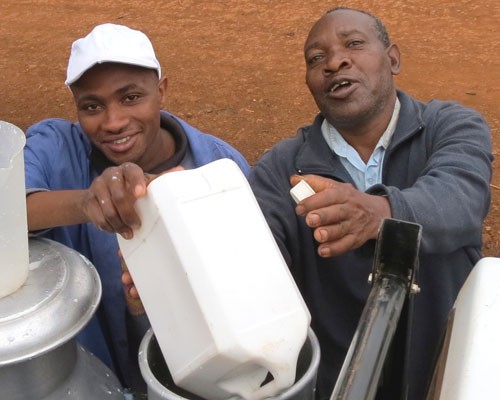
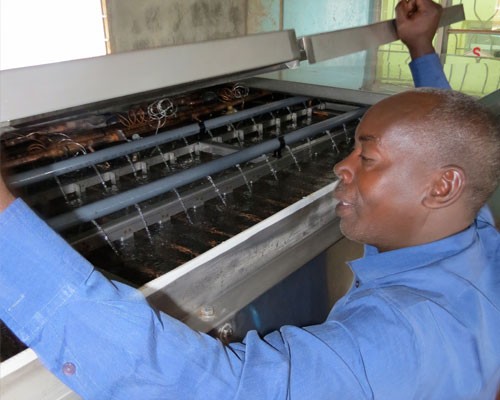
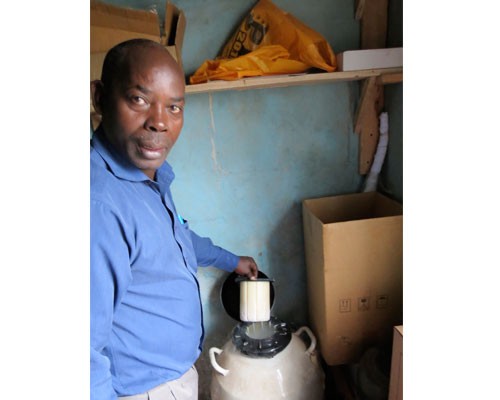
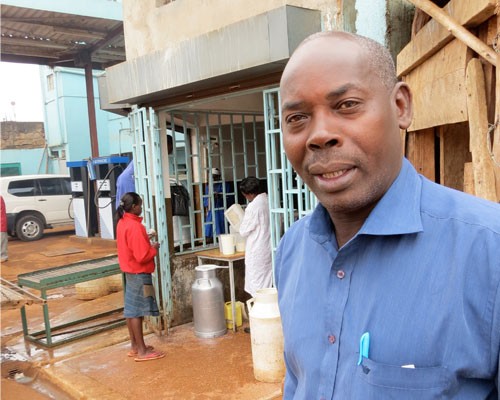
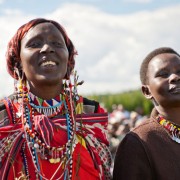
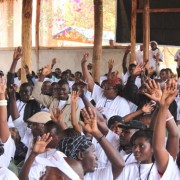
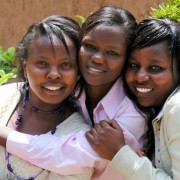
Comment
Make a general inquiry or suggest an improvement.